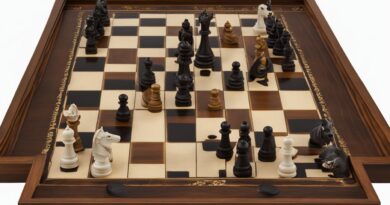Chess Openings The Scheveningen Variation
Chess openings are a must for any successful game. They determine the course of play from the very start. Moves made in the beginning lay the foundation for future moves and the outcome. So, players must understand various strategies and their implications.
Every opening has its own characteristics, strengths and weaknesses. Players can either reflect their style or respond to their opponent’s moves. Some openings control the center while others focus on rapid development or piece mobility. Understanding these approaches help players make informed decisions.
The Trompowsky Attack is an unconventional opening starting with 1.d4 Nf6 2.Bg5. It was named after Octavio Trompowsky. This aggressive move disrupts the development plans of the opponent. It offers White creative play and psychological advantages.
An example: Anatoly Karpov played a variation of Sicilian Defense, called “Scheveningen Variation” against Garry Kasparov during their 1987 World Chess Championship match. This unexpected move caught Kasparov off guard and gave Karpov an early edge.
Chess openings are like portals to a world of strategy and creativity. Players use them to tell their unique stories and challenge each other. As we explore variations like the Scheveningen or Trompowsky Attack, we discover more of this timeless game that fascinates novices and experts alike.
Overview of the Scheveningen Variation
The Scheveningen Variation is a chess opening that provides players with great tactical flexibility. Experienced players appreciate its offensive and defensive capabilities. Let’s explore the key features of this variation:
- Flexibility in Piece Development: Players can move their pieces freely while responding to game situations.
- Solid Pawn Structure: This leads to a strong foundation for future plans.
- Attacking Opportunities: Players can attack their opponent’s position, targeting weaknesses in their pawn structure.
- Defensive Capabilities: Players can counterattack and defend their own position.
- Endgame Prospects: Balanced pawn structure and piece coordination make it a great option for endgames.
This variation needs careful planning and precise executions. Positional imbalances change dynamically, so players need to analyze the game and estimate possible outcomes. Here are some tips to improve gameplay:
- Coordinate Attacks: Harmonize pieces positions and use multiple units together in attacks.
- Take Advantage of Weaknesses: Identify weaknesses in the pawn structure and attack them.
- Look for Tactical Opportunities: Be ready to exploit unexpected combinations or sacrifices.
- Prioritize King Safety: Castle early and maintain a safe defensive setup.
By following these suggestions, players can use the Scheveningen Variation to their advantage. Analyzing the game and adapting strategies accordingly will lead to success in chess!
Historical Background of the Scheveningen Variation
The Scheveningen Variation of chess openings is centuries old. It originated in mid-19th century Scheveningen, a Dutch town. This variation is renowned for its strategic elements and flexibility.
Black’s move of pawn to e6 is typical of the Scheveningen Variation. It helps to secure the d5 square while still being able to attack. This opening allows for dynamic play, making it popular among grandmasters.
The Scheveningen Variation follows chess strategy fundamentals. It encourages piece development and center control, and allows for different strategies.
In 1972, the World Chess Championship match between Boris Spassky and Bobby Fischer featured this variation. Fischer used it effectively against Spassky, helping to make it well-known.
The Scheveningen Variation is still studied and analyzed by chess enthusiasts, showcasing the game’s tradition and innovation. New discoveries are made through its exploration, keeping it an exciting option for those seeking thrill and challenge on the chessboard.
Key Principles and Strategies of the Scheveningen Variation
The Scheveningen Variation of chess openings is known for its key principles and strategies. These tactics are designed to boost control over the center of the board, create strong pawn structures, and let pieces move flexibly. By understanding and using them well, players can gain an advantage.
Let’s look at a table of the key principles and strategies:
| Key Principles | Strategies |
|---|---|
| Control the Center | Place pawns, knights, and bishops in the central squares. Limit the opponent’s mobility and expand your own options. |
| Create Pawn Structures | Aim for pawn formations that offer stability and tactical opportunities. The typical pawn structure has a pawn on d6, with e6 and c6 also supported. |
| Flexible Piece Development | Move pieces in harmony, placing them on effective squares. Knights should go to d7 or f5, while bishops should be on e6 or g7. |
| King Safety | Keep your king safe by castling early or shielding it with pawns. Be aware of any weaknesses in the opponent’s king position. |
Players must balance attack and defense while playing the Scheveningen Variation. Stay alert to tactical threats and take any chances to counterattack.
This variation got its name from the Dutch coastal town where it was first used in competitive play. It became popular in the late 19th century and many grandmasters now use it because of its complexity and flexibility.
By understanding the key principles, strategies, and history, players can approach the Scheveningen Variation with more knowledge and aim to win.
Notable Players and Games in the Scheveningen Variation
Chess is a game that has enchanted many enthusiasts for years – one of its most captivating variations is the Scheveningen Variation. Notable players and games have made their mark on the chess world.
- Anatoly Karpov: Grandmaster Anatoly Karpov is a well-known name in this variation. His strategic acumen and exact calculations made him a powerful force.
- Garry Kasparov: Chess icon Garry Kasparov is renowned for his resolute style and tactical genius. His games in this variation have entranced spectators around the globe.
- Bobby Fischer: Bobby Fischer is essential to any chess variation. His analytical skills and unique approach gave a fresh slant to the Scheveningen Variation.
- Viktor Korchnoi: Viktor Korchnoi’s contributions to chess are irrefutable. He has left his mark in the Scheveningen Variation with his tenacity and resilience.
Stimulating, closely fought games have kept fans enthralled. The battles between these remarkable players displayed their outstanding skills and strategic brilliance.
Plus, their dedication to constant improvement and novel ideas has had an immense influence on how this variation is played today. Their ingenious moves and inventive strategies have inspired many future generations of chess players.
Common Subvariations in the Scheveningen Variation
The Scheveningen Variation of chess openings has several common subvariations. Let’s look at these subvariations and the strategies they involve.
Below is a table showing the common subvariations of Scheveningen Variation, and their main characteristics:
| Subvariation | Key Features |
|---|---|
| 6.Be3 | Gives various attacking and defensive options. |
| 6.Bg5 | A more aggressive approach. |
| 6.f4 | Very aggressive, often leading to sharp positions. |
| 6.g3 | Builds a strong pawn structure. |
Let’s talk about extra details of these subvariations. 6.Be3 controls the d4 square and allows for queenside castling. 6.Bg5 creates weaknesses in Black’s position by pinning the knight on f6. 6.f4 challenges Black’s central pawn structure. 6.g3 develops pieces and sets up for kingside castling.
A few tips to make the most of these subvariations:
- Learn typical middlegame plans for each variant. Understand strategic ideas unique to each move order.
- Analyze master games in these subvariations. Grasp key concepts through real-life examples.
Advantages and Disadvantages of Playing the Scheveningen Variation
The Scheveningen Variation of chess has pros and cons. Let’s examine them.
Pros:
- Flexiblity in piece development
- Counterplay opportunities
- Strategic complexity
- Unbalanced positions
Cons:
- Deep understanding of positional play needed
- Difficult to master
- Complex positions may arise
- Tactical vulnerabilites
Note that the Scheveningen Variation requires a lot of positional knowledge, so it may not suit those who rely only on tactics.
A funny story about the Scheveningen Variation: Once, a grandmaster was taken by surprise when his opponent used it in a tournament. It was tough, but the grandmaster adapted and won with a combination of positional and tactical moves.
So, the Scheveningen Variation is tough but rewarding for those who tackle its complexities.
Tips and Strategies for Playing the Scheveningen Variation
Chess Openings – The Scheveningen Variation is a popular choice for those who want to add a bit of style to their game. Here’s what you need to remember in order to excel:
- Piece Development: Make sure you bring out your knights and bishops efficiently. This will help control the center and create a strong base.
- Center Control: Dominate d4, d5, e4, and e5 squares to gain better mobility and stop your opponent from making moves.
- Pawn Structure: Keep a solid pawn chain for stability. Avoid weaknesses that can be exploited later.
- Tactics: Always be ready for pins, forks, skewers, or any other tactics that may come up.
- Piece Outposts: Find places for pieces to have maximum influence. Centralized or enemy-based squares work best.
These serve a purpose:
- Piece development = control.
- Controlling the center = denying space.
- Good pawn structure = stability.
- Tactical awareness = advantage.
- Piece outposts = influence and coordination.
By following these tips, you’ll get better at the Scheveningen Variation. Embrace its complexity and strategic possibilities for a thrilling chess battle.
Conclusion: The Impact and Continuation of the Scheveningen Variation in Modern Chess.
The Scheveningen Variation has had a huge effect on chess. Known for its flexible pawn setup and intense play, it has become a classic in grandmaster games.
This variation has the power to fit any situation. Closed positions need strategy; open positions need tactics – the Scheveningen Variation covers them both. It has even been successful against white’s opening systems. Its dynamism creates complex middlegames, where both sides have a fair chance of winning.
Garry Kasparov and Magnus Carlsen are two masterful players who have used the Scheveningen Variation in tournaments. They’ve been an inspiration to countless aspiring chess players.
It is essential for chess fans to understand the Scheveningen Variation and all its potential. Incorporating it into your game will give you an edge. Unleash your creativity on the chessboard and join the great players who have made their mark with this opening. Prepare yourself for thrilling challenges and endless learning in modern chess. Don’t miss out – elevate your game with the Scheveningen Variation!


